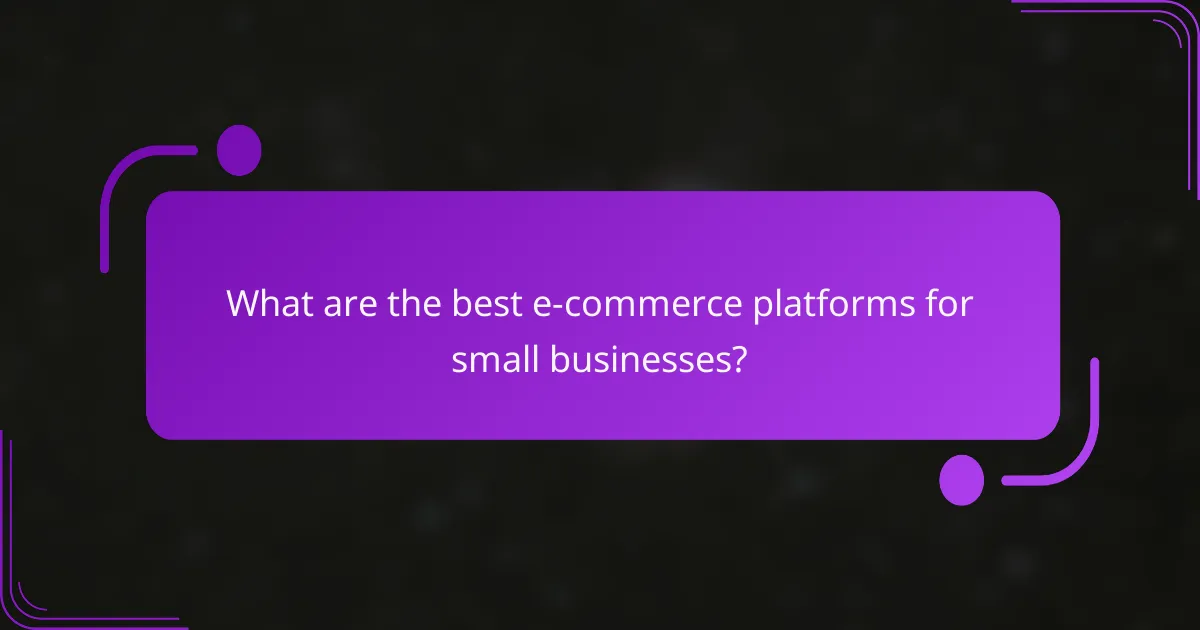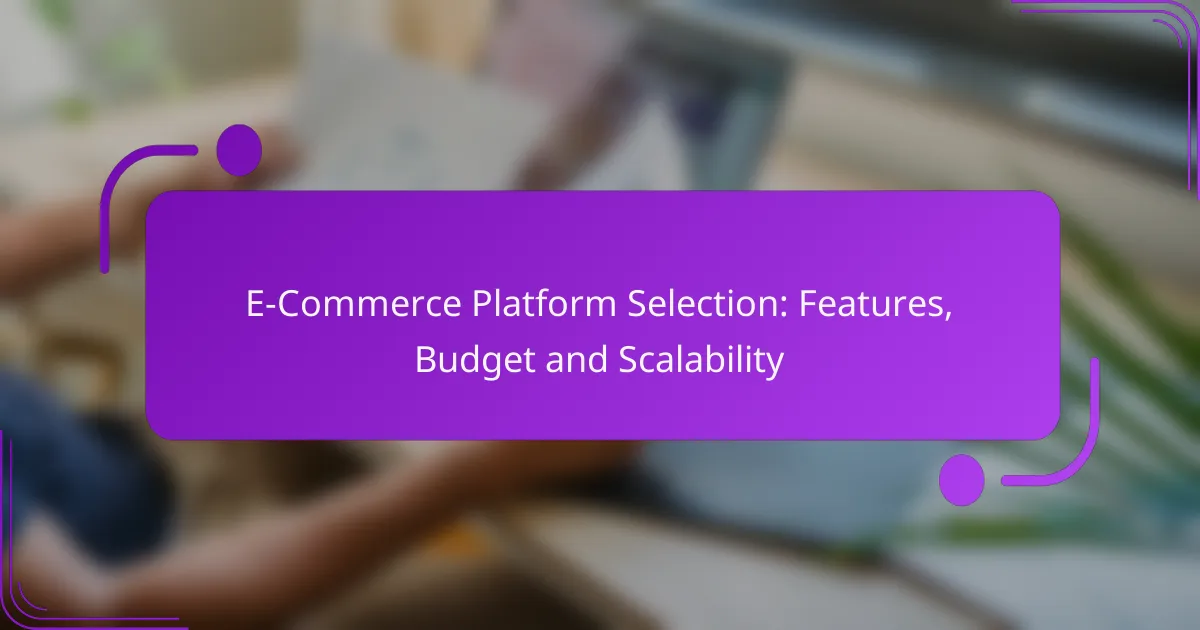Choosing the right e-commerce platform is crucial for small businesses, as it impacts user experience, operational efficiency, and growth potential. Key considerations include essential features, budget constraints, and the ability to scale with your business needs. Popular platforms like Shopify, WooCommerce, and BigCommerce offer various functionalities to cater to different requirements and financial plans.

What are the best e-commerce platforms for small businesses?
The best e-commerce platforms for small businesses typically offer a balance of user-friendliness, essential features, and affordability. Popular options include Shopify, WooCommerce, and BigCommerce, each catering to different needs and growth stages.
Shopify features and pricing
Shopify is known for its intuitive interface and robust features, making it ideal for small businesses. Key features include customizable templates, integrated payment processing, and mobile optimization. Pricing starts around $29 per month, with additional costs for premium themes and apps.
When selecting Shopify, consider transaction fees if you opt for third-party payment gateways. The platform also offers a 14-day free trial, allowing you to test its capabilities before committing.
WooCommerce flexibility and scalability
WooCommerce is a plugin for WordPress that provides extensive flexibility and scalability for small businesses. It allows for complete customization, enabling users to tailor their online store to specific needs. While the plugin itself is free, costs can arise from hosting, themes, and additional plugins.
WooCommerce is particularly suitable for businesses anticipating growth, as it can handle increasing traffic and sales volume. However, managing a WooCommerce store requires some technical knowledge, especially for updates and security measures.
BigCommerce for growth
BigCommerce is designed for businesses looking to scale quickly, offering built-in features that support growth without the need for extensive add-ons. It includes tools for SEO, multi-channel selling, and advanced analytics. Pricing starts at approximately $29.95 per month, with higher tiers for larger businesses.
One advantage of BigCommerce is its lack of transaction fees, which can save money as sales increase. However, it may be less user-friendly for those unfamiliar with e-commerce technology, so consider your team’s capabilities when choosing this platform.

How to choose an e-commerce platform based on features?
Selecting an e-commerce platform based on features involves identifying the essential tools and capabilities that align with your business needs. Prioritize functionalities that enhance user experience, streamline operations, and support growth.
Essential features for online stores
Key features for online stores include a user-friendly interface, mobile responsiveness, secure payment gateways, and inventory management tools. Additionally, consider options for SEO optimization, customer support, and analytics to track performance.
Other important functionalities might include multi-channel selling capabilities, customizable templates, and integration with third-party applications. These features can significantly enhance your store’s efficiency and customer engagement.
Comparative analysis of features
When comparing e-commerce platforms, evaluate their feature sets against your business requirements. Create a checklist of must-have features and rank platforms based on how well they meet these criteria.
For example, if you prioritize payment security, look for platforms that offer PCI compliance and fraud protection. If scalability is crucial, choose platforms that can handle increased traffic and sales volume without performance issues.
Utilize online reviews and comparison tools to gather insights on user experiences with different platforms. This can help you identify potential pitfalls and advantages, ensuring you select a solution that best fits your operational needs.

What is the budget range for e-commerce platforms?
The budget for e-commerce platforms typically ranges from a few hundred to several thousand dollars per month, depending on the features and scalability needed. Businesses should consider both upfront costs and ongoing expenses to effectively plan their e-commerce strategy.
Monthly costs of popular platforms
Monthly costs for e-commerce platforms can vary significantly. For instance, platforms like Shopify and BigCommerce generally charge between $29 and $299 per month, while more customizable solutions like WooCommerce may have lower base costs but require additional hosting fees.
Enterprise-level solutions, such as Magento or Salesforce Commerce Cloud, can exceed $1,000 per month, often tailored to larger businesses with specific needs. It’s crucial to evaluate what features are included in each pricing tier to ensure they align with your business goals.
Hidden fees to consider
When budgeting for an e-commerce platform, be aware of potential hidden fees. Transaction fees can apply, especially on platforms like Shopify, which may charge a percentage on sales unless you use their payment processor.
Additionally, costs for themes, plugins, and third-party integrations can add up. It’s advisable to account for these extras in your overall budget to avoid surprises later on. Always read the fine print and ask for a detailed breakdown of all potential costs before committing to a platform.

How does scalability affect e-commerce platform selection?
Scalability is crucial in e-commerce platform selection as it determines how well a platform can handle growth in traffic, sales, and product listings. A scalable platform ensures that as your business expands, it can accommodate increased demand without significant performance issues or additional costs.
Scalability features in Shopify
Shopify is designed with scalability in mind, allowing businesses to grow seamlessly. It offers various plans that cater to different business sizes, from startups to large enterprises, ensuring that you can upgrade as needed without migrating to a new platform.
Key scalability features include automatic bandwidth allocation during peak times, a vast app ecosystem for enhanced functionality, and built-in tools for managing inventory and sales. Additionally, Shopify’s hosting is robust, providing fast load times even as traffic increases.
Growth potential with WooCommerce
WooCommerce, as a plugin for WordPress, offers significant growth potential due to its flexibility and customization options. It allows businesses to scale by adding various extensions and features tailored to specific needs, such as payment gateways, shipping options, and marketing tools.
However, scalability with WooCommerce requires careful management of hosting resources, as performance can decline with increased traffic if the hosting environment is not optimized. Choosing a reliable hosting provider and implementing caching solutions can help maintain speed and efficiency as your store grows.

What are the prerequisites for selecting an e-commerce platform?
When selecting an e-commerce platform, it’s essential to assess your business needs, budget constraints, and scalability requirements. A clear understanding of these prerequisites will help you choose a platform that aligns with your operational goals and growth potential.
Business model considerations
Your business model significantly influences the choice of an e-commerce platform. Whether you operate a B2C, B2B, or C2C model, the platform should support the specific functionalities required for your transactions. For example, B2B platforms often need features like bulk ordering and customer-specific pricing, while B2C platforms may prioritize user-friendly interfaces and mobile responsiveness.
Additionally, consider the sales channels you plan to utilize. If you intend to sell through multiple channels, such as social media or marketplaces, ensure the platform offers integrations with these channels. This flexibility can enhance your reach and streamline operations.
Technical requirements
Technical requirements encompass the necessary infrastructure and features your e-commerce platform must have to function effectively. Assess your current technology stack and determine compatibility with the platform. Look for essential features like payment gateways, security protocols, and hosting capabilities.
Another critical aspect is scalability. As your business grows, the platform should accommodate increased traffic and transactions without compromising performance. Ensure the platform can handle high volumes of data and offers options for upgrading resources as needed. A good rule of thumb is to choose a platform that can manage at least double your current expected traffic.

How do payment gateways impact e-commerce platform choice?
Payment gateways are crucial in determining which e-commerce platform to select, as they facilitate transactions between customers and merchants. The choice of payment gateway affects transaction fees, integration ease, and the overall customer experience, making it essential to consider these factors when selecting an e-commerce solution.
Popular payment gateways for Shopify
Shopify supports a variety of payment gateways, including Shopify Payments, PayPal, and Stripe. Shopify Payments is the most integrated option, allowing for seamless transactions without additional fees, while PayPal and Stripe offer flexibility for international sales.
When choosing a payment gateway for Shopify, consider transaction fees, currency support, and ease of integration. For instance, Shopify Payments has lower fees for U.S. merchants, while PayPal is widely recognized and trusted by customers globally.
WooCommerce payment integration options
WooCommerce offers extensive payment integration options, including PayPal, Stripe, and Authorize.Net. These gateways can be easily added through plugins, allowing for customization based on business needs.
When selecting a payment gateway for WooCommerce, evaluate factors such as transaction costs, supported currencies, and customer service. PayPal is popular for its ease of use, while Stripe is favored for its advanced features and competitive rates.
